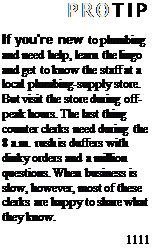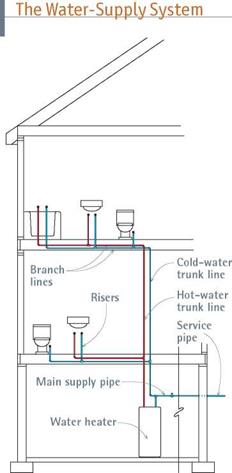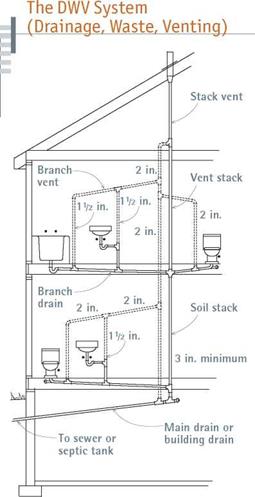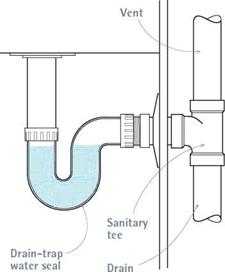An Overview of Plumbing Systems
A plumbing system is a loop of sorts, created by supply (or delivery) pipes that carry potable water to the house and its fixtures and by drainage, waste, and venting (DWV) pipes that carry waste water, effluvia, and sewage gases away from the fixtures—sinks, toilets, lavatories, washing machines, and so on.
These two systems within a system are quite different from each other. DWV pipes are larger and must slope downward so wastes can fall freely (by gravity) and sewage gases can rise through vents. Consequently, large DWV pipes can be difficult to route through framing. By contrast, smaller water-supply pipes are easy to run through studs and joists, and they deliver water under pressure, so there’s no need to slope them.
The pipe that delivers water to a house (from a city water main or an individual well) is called the service pipe. So it won’t freeze, a service pipe must run below the frost line and enter a building through its foundation. Typically, a 1-in. service pipe is controlled by a main shutoff valve shortly after it enters a building; but municipal hookups may enter a water meter first. Plumbing codes may also require a pressure-reducing valve if water pressure is more than 80 psi (pounds per square inch).
On the other side of the shutoff valve, the service pipe continues as the main supply pipe, commonly % in. in diameter. At some point, the main supply pipe enters a tee fitting, at which point it splits, with one leg continuing on as a cold-water trunk line and the other feeding into the water heater, where it emerges as the hot-water trunk line. From the 14-in. hot and cold trunks run various /2-in. branch lines that serve fixture groups. Finally, individual risers (supply tubes) run from branch lines to fixtures. Risers are % in. or 12 in. in diameter and connect to fixtures with threaded fittings. By decreasing in diameter as they get farther from the trunk lines, supply pipes help maintain constant water pressure.
Before the 1950s, supply pipes were usually galvanized steel, joined by threaded fixtures, but steel pipes corrode and corrosion constricts flow. Consequently, rigid copper piping, which corrodes more slowly, soon replaced galvanized. Joined by soldering (sweat fitting), copper was also easier to install and has been the dominant supply piping since the 1950s. Rigid plastic pipe, especially CPVC (chlorinated polyvinyl chloride), has gained market share because it is corrosion
|
|
Originating at a service pipe from the street (or from a well), the main supply pipe splits at a T-fitting, with one leg feeding cold-water trunk lines and the other entering the water heater to emerge as the hot-water trunk line.
resistant, less expensive than copper, and easily assembled with solvent cement. But it may be PEX (cross-linked polyethylene) flexible piping that will finally dethrone King Copper (PEX is discussed later in this chapter).
The DWV system carries wastes and sewage gases away from the house.
► Every fixture has a drain trap designed to remain filled with water after the fixture empties. This residual water keeps sewage gases from rising into living spaces. (Toilets have integral traps.) As trap arms leave individual fixtures, they empty into branch drains or directly into a soil stack, which, at its base, turns and becomes the main drain. The main drain then discharges into a city sewer main or a septic tank.
►  Drainpipes may also be differentiated according to the wastes they carry: soil pipes and soil stacks carry fecal matter and urine, whereas waste pipes carry waste water but not soil. Stacks are vertical pipes, although they may jog slightly to avoid obstacles.
Drainpipes may also be differentiated according to the wastes they carry: soil pipes and soil stacks carry fecal matter and urine, whereas waste pipes carry waste water but not soil. Stacks are vertical pipes, although they may jog slightly to avoid obstacles.
► Venting is the Fin DWV. Without venting, wastes would either not fall at all or, in falling, would suck the water out of fixture traps, allowing sewage gases to enter living spaces. Vents admit an amount of air equal to that displaced by the falling water. Thus every fixture must be vented. In most cases, the trap arm exits into a tee fitting whose bottom leg is a branch drain and whose upper leg is a branch vent. Branch vents continue upward, often joining other fixture vents, until they join a vent stack, which exits through the roof.
|
|
Drainpipes must slope downward at least ‘/4 in. per foot so wastes can fall freely. Vent pipes must slope upward at least ‘/8 in. per foot so sewage gases can rise and exit the building.
Because vents must admit enough air to offset that displaced by falling water, vents are approximately the same size as their companion drains. Branch vents and drains are usually 112-in. or 2-in. pipes, and main stacks and drains are 3 in. Minimums are indicated in "Minimum Drain, Trap, and Vent Sizes,” on p. 281. Important: Drainpipes must slope downward at least ‘/a in. per foot so that wastes will be carried out; vent pipes usually slope upward a minimun of 18 in. per foot.
DWV pipes may be of any number of materials. Thus an older house may have drain and vent pipes with sections of cast iron, galvanized steel, copper, or plastic. Because some of these materials are also used for supply, let size be your guide: If an existing pipe’s diameter is 114 in. to 4 in., it’s a drain or vent pipe. DWV pipes installed these days are mostly plastic: white PVC (polyvinyl chloride) or black ABS (acrylonitrile butadiene styrene). Fortunately, there is a host of ingenious fittings that enable you to tightly connect these various materials, should you need to. Note: If sound suppression is an issue, you should insulate plastic pipes or install cast iron.
|
|
Water traps seal sewage gases from living spaces, but they need vents to operate properly. Without incoming air from the vent, falling wastes could suck the water out of traps.









Leave a reply